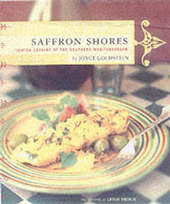
|
Saffron Shores: Jewish Cooking of the Southern Mediterranean
Hardback
Main Details
| Title |
Saffron Shores: Jewish Cooking of the Southern Mediterranean
|
| Authors and Contributors |
By (author) Joyce Goldstein
|
| Physical Properties |
| Format:Hardback | | Pages:194 | | Dimensions(mm): Height 228,Width 219 |
|
| Category/Genre | General cookery and recipes
National and regional cuisine |
|---|
| ISBN/Barcode |
9780811830522
|
| Classifications | Dewey:641.5676 |
|---|
| Audience | |
|---|
| Illustrations |
36 colour photographs
|
|
Publishing Details |
| Publisher |
Chronicle Books
|
| Imprint |
Chronicle Books
|
| Publication Date |
5 September 2002 |
| Publication Country |
United States
|
Description
Celebrated chef and author Joyce Goldstein continues her exploration of the food and flavours of Jewish cooking of the Mediterranean. As she traces the culinary trail of the diaspora (the migration of Jews throughout Europe and Arab countries), Joyce turns an affectionate gaze to the spice-infused dishes of the Maghrebi - the people of Morocco, Algeria, Tunisia, and Libya. From traditional omelettes laced with the homemade spice mixtures of harissa or ras al hanout to B'Stilla - classic chicken and almond pies-the Sephardic people freely exchanged recipes and ingredients with their non-Jewish friends and neighbours. These dishes were not only rich with the flavours of their new home, but also conformed to kosher law. Thus the daily meals for North African Jews might offer delightful dishes of Ojja bil Merguez (a Tunisian omelet of sausage, potatoes and peppers), or Mrouzia (Lamb tagine with prunces and honey), illustrating a perfect balance of cultures, bite after spicy bite. Sephardic cuisine defies narrow definition, so Joyce has included Judeo/Arabic recipes from Lebanon and Syria - treats like buttery Sambusaks (cheese-filled pastries from Syria) and Samak al Camoun (Lebanese broiled fish seasoned with cumin) - specialties that continue to influence the Maghrebi palate. This wonderful cookbook is also beautifully illustrated with rich colour photographs of the recipes - many served on traditional Moroccan pottery. An extensive bibliography is a tempting incentive to learn more about the rich culinary history of this fascinating region and the people who live there. No one knows more about the Jewish food of Northern Africa than Joyce Goldstein.
Author Biography
Joyce Goldstein is a nationally known chef, author, teacher, and Mediterranean cooking expert. Her numerous prior books include Enoteca, Sephardic Flavors,and Cucina Ebraica, all published by Chronicle Books. She lives in San Francisco.
ReviewsSouthern lights Saffron Shores offers Jewish food from the lower Mediterranean Joyce Goldstein wants to change everything you thought you knew about Jewish culinary traditions. Many Americans associate Jewish cooking with Eastern European flavors (such as chicken fat, onions, and sour cream). But Goldstein's research into Mediterranean Jewish food has opened up a world of different tastes. Her newest cookbook, "Saffron Shores: Jewish Cooking of the Southern Mediterranean," isn't for the novice cook; many recipes are challenging. But it is a beautiful treasure trove of dishes from the Jewish communities of North Africa. Some will seem familiar - spiced roast lamb with couscous and harissa from Morocco, for instance - whereas others are more exotic, like a green pureed soup of fava beans and cilantro, garnished with chicken gizzards, for Passover. "Saffron Shores" is full of fresh ideas for all the Jewish holidays. For Hanukkah, it is traditional to eat oil-rich foods in honor of the miracle of a Temple lamp that burned for eight days with only one day's supply of oil. Goldstein suggests serving sweet or savory fried pastries, such as classic North African "briks" (spicy filled turnovers). We found more than one reason to like these mashed potato-filled Tunisian pastries, adapted from Goldstein's recipe first, because they're easy to put together (egg roll wrappers fry up beautifully, and the thick filling doesn't leak out), and second, because they taste like a subtle twist on comfortingly familiar latkes. - Sunset Magazine
|